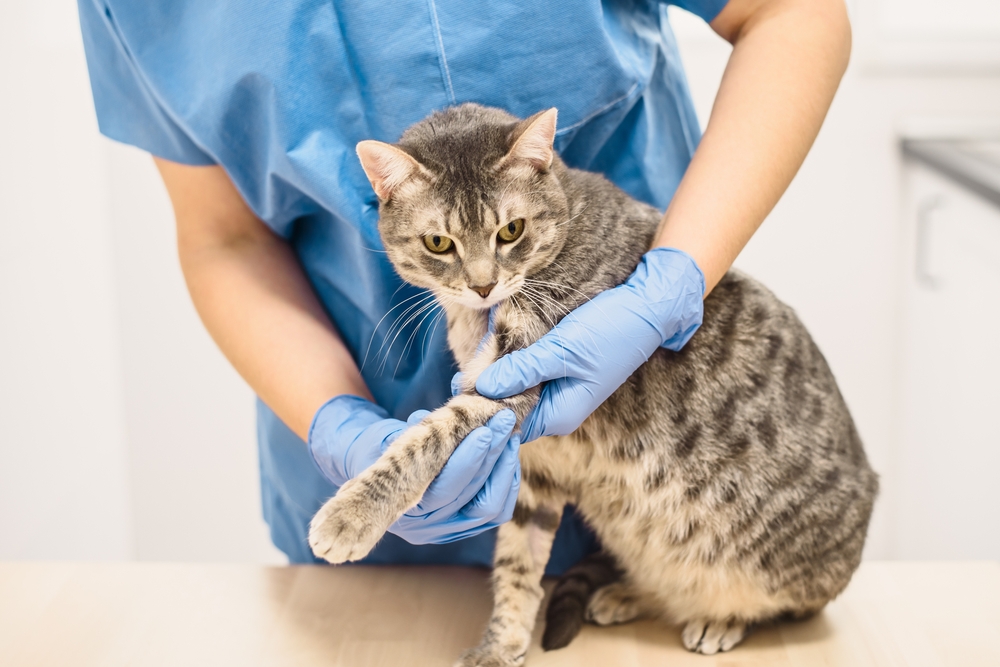Arthritis commonly affects many species, including humans, dogs, and cats. We know that arthritis pain can be debilitating and is recognized easily in humans and dogs, but owners and veterinarians often fail to address these changes in cats. Our Star of Texas Veterinary Hospital team knows how pain can impact your furry pal’s quality of life and wants to educate pet owners on feline arthritis signs, diagnosis, and treatment options.
What is feline arthritis?
Arthritis—technically osteoarthritis—is an inflammatory process that causes tissue breakdown in joints. Any joint can be affected, but the spine, hip, elbow, and hock (i.e., ankle) are most common in cats. Arthritic joints become inflamed, cartilage deteriorates, and bone spurs (i.e., osteophytes) may develop. The degenerative process causes pain, swelling, and reduced mobility, and the disuse encourages further joint deterioration and muscle atrophy. Most feline arthritis cases have no discernable underlying cause, but older age, obesity, and a history of injury or development issues in specific joints increase the risks.
How prevalent is arthritis in cats?
Recent studies show that around 40% of cats show arthritis signs and 90% of cats older than 12 years. This incidence is higher than in dogs yet, unfortunately, only an estimated 13% of arthritic felines are diagnosed and treated. This lack of awareness is likely because cats show more subtle signs and don’t typically require the same assistance as arthritic dogs. Pet owners, who often overlook the importance of routine wellness examinations, also take their cats to the veterinarian less frequently than dogs.
What arthritis signs should I look for in my cat?
Cat owners, with their untrained eye, can easily miss arthritis signs or mistake them for normal aging changes. The condition may present with primarily physical signs, primarily behavioral signs, or a combination. The most commonly reported changes in cats include:
- Hesitation or difficulty jumping
- Overall reduced agility or mobility
- Difficulty with stairs
- Reduced grooming
- Difficulty rising
- Behavior changes (e.g., hiding, less play, aggression)
- Litter box habit changes
- Decreased overall activity
How do veterinarians diagnose feline arthritis?
Veterinarians use a combination of history, physical examination findings, and X-rays to diagnose arthritis. Screening cats older than 7 years with a questionnaire for pet owners may provide improved disease detection, because although pet owners notice changes, they may not recognize them as potential problems until specifically asked. Our team uses Fear Free and Cat Friendly examination techniques to help cats feel relaxed in the veterinary hospital, which helps us observe their natural behaviors and mobility patterns. For cats who prefer to skip the orthopedic examination, at-home videos may assist in diagnosis.
What treatment options are available for feline arthritis?

Arthritis treatment goals in cats are controlling pain and improving mobility. Untreated pain can detrimentally affect the brain and behavior, and can gradually worsen as the nervous system becomes overly sensitized. Pain can also decrease your cat’s overall quality of life and damage your bond.
Treatment options are chosen based on your cat’s temperament, because attempting to daily medicate an uncooperative cat can also damage your bond. Other health conditions, such as kidney disease, are also factors. Available treatment options include:
- Short-term anti-inflammatories
- Oral pain medications (e.g., opioids, gabapentin)
- Physical therapy (e.g., massage, range of motion, hydrotherapy, ultrasound)
- Laser therapy
- Monthly injectable monoclonal antibodies (i.e., Solensia)
- Oral or injectable joint protectants (i.e., Adequan)
- Surgery
- Controlled exercise
- Therapeutic diet
- Weight loss
You can also help your arthritic cat by modifying your home environment so they can more easily access resources, and to encourage more movement. Try the following:
- A low-sided litter box and at least one box on each floor to reduce accidents
- Ramps to access favorite furniture
- Cat trees with easy, low-step intervals
- Cushioned bedding
- Daily play sessions with toys, a laser, or food puzzles
Cats are still closely related to their wild ancestors and retain the instinctual ability to hide pain, discomfort, and illness, but learning the signs and recognizing subtle changes at home can prompt you to seek help from our Star of Texas Veterinary Hospital team sooner. Contact us to schedule a visit for your cat if you suspect arthritis pain, see behavior or habit changes, or if they are due for their annual wellness checkup.






